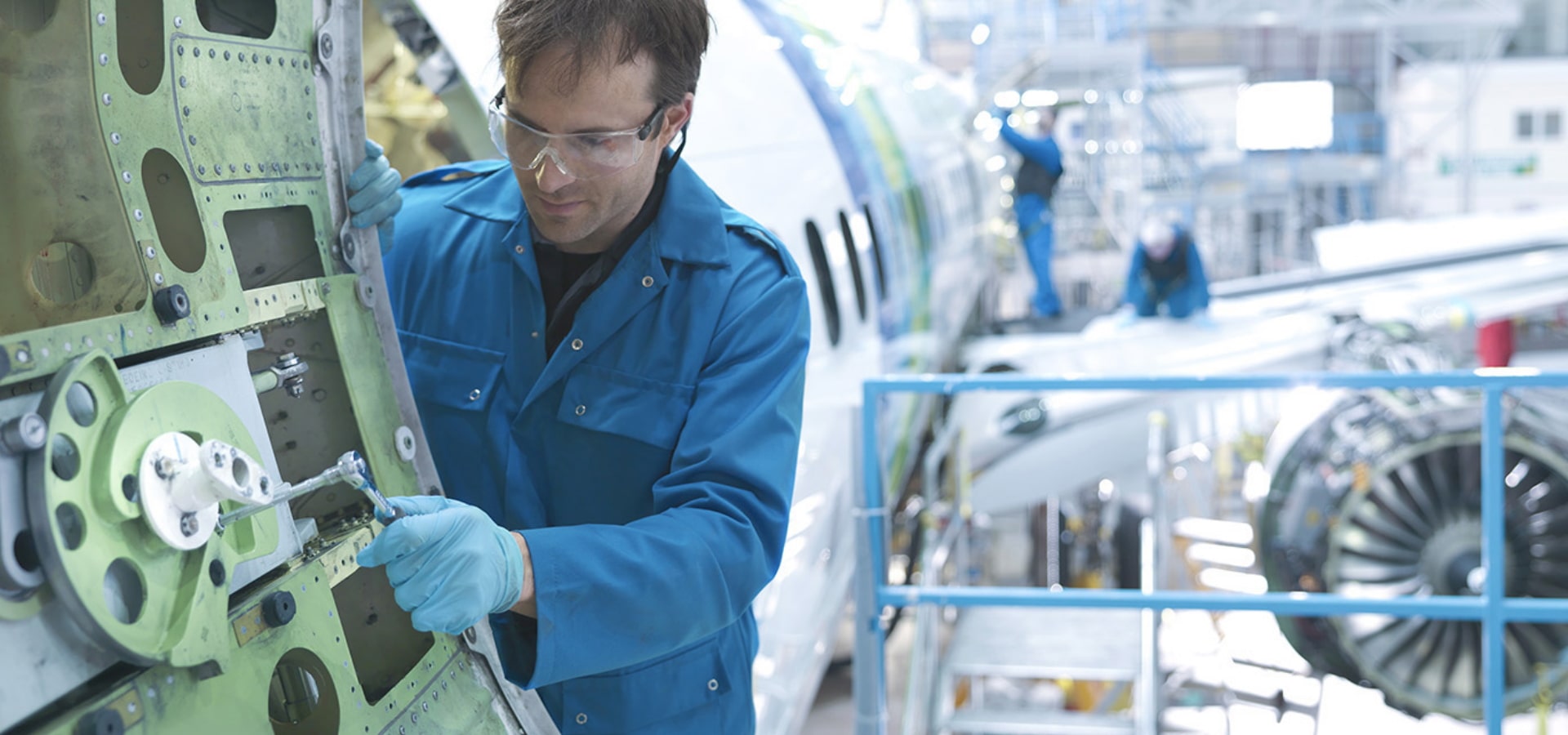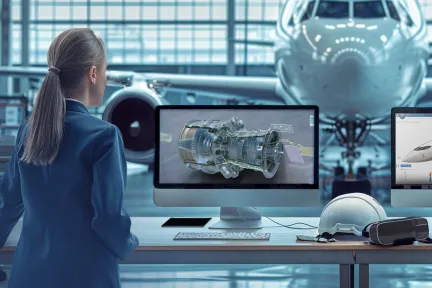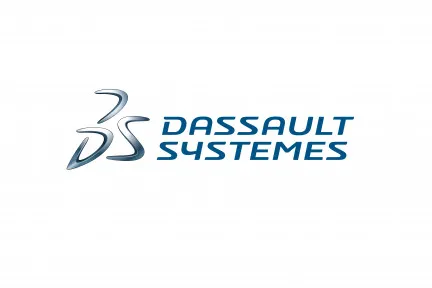Enable Flexible Production
FUTURE FACTORY - A Transformation Imperative
The manufacturing landscape faces dramatic change. Creating and capturing value requires aerospace companies to understand what’s driving these changes and the role digital transformation plays in determining the future.
Overview of the Aerospace & Defense Industry's Need for Adaptability and Efficiency
In the fast-paced aerospace and defense industry, adaptability and efficiency are paramount. Indeed, the swift technological advancements, geopolitical tensions, unpredictable supply chain disruptions, environmental challenge, as well as a variety of new entrant OEMs (Original Equipment Manufacturers) producing new classes of aircraft for the Advanced Air Mobility Market drive suppliers to embrace flexibility. Companies must leverage the best technologies to stay competitive. Advanced solutions from Dassault Systèmes help the A&D ecosystem adapt to changes and manage the increased complexity of A&D products requirements.
The Need for Flexibility in Aerospace Manufacturing
Production flexibility, supply chain resiliency, and Quality continue to have significant focus as many suppliers were heavily impacted by the pandemic and supply chain crises, making flexibility, smart factories, and digital innovation more important than ever. Such unpredictable events have rippled through every aspect of the industry, from a dramatic fall in passenger demand to supply chain interruptions, workforce disruptions, significant reductions in Maintenance, Repair, and Overhaul (MRO) activities, and extreme financial pressures.
The airline industry, grappling with these challenges, had responded by canceling or deferring orders and requesting model switches. With decisions to retire older models and reassess fleet requirements, there has been a pressing need for the A&D industry to realign aircraft production and aftermarket services with these evolving demands, impacting drastically the supply chain and creating enormous backlogs. The demand for new aircrafts is closely linked to the air traffic numbers. Those numbers are steadily increasing to return to their pre-pandemic averages. However, as we have seen previously, aircraft orders were reaching record highs at the end of 2021. This confirms us in our hypothesis that demand will continue being variable, requesting flexibility in the A&D industry’s supply chain.
To navigate this turbulent landscape, A&D companies must harness flexible manufacturing systems and leverage automation to dynamically match production with fluctuating demand. This involves utilizing advanced software and robotics to enhance production processes, manage parts and material inventories more efficiently, and control production workflows to optimize quality and sustainability.
By adopting such flexible and innovative production strategies, the A&D industry can better manage the shifts in demand and prepare for future challenges, ensuring resilience and agility in its global operations. Companies must dynamically match production with demand while improving quality & sustainability, lowering costs, ensuring worker safety and health, and deliver on time.
Discover How Dassault Systèmes Implements Flexible Rate to Adapt to Market Influences and Demand
3DS’ Approach to Flexible Production
The 3DEXPERIENCE® platform connects the dots to enable an agile production rate with quality goals: Agile and resilient companies can eliminate costs, quality issues, and waste virtually before production starts. They can plan their production system strategic upgrades and anticipate potential issues before they occur, simulate multiple scenarios rapidly to determine the best course of action, and have the flexibility in their production systems and methods to meet new sustainable market demands.
Moreover, the platform enhances flexible manufacturing capabilities by providing tools for production and supply chain scheduling, allowing for “what if” scenarios and capacity planning to adeptly address market demand changes. It connects planning to the shop floor through a “virtual twin” to anticipate issues, and take proactive actions to flexibly match production rates. This integration leverages automation and computer control, facilitating the use of data and machine operations to optimize the entire manufacturing process.
Connecting disciplines and departments into a unique platform will reduce development time and response time to changes by 30% and drastically reduce manual data processing. Manufacturing flexibility will accelerate time to delivery and adaptation to clients’ demand.
Spotlight on Flexible Production
Improve decision-making to stay on budget and on time through 360 degree planning, simulation, and real-time insights.
Improve manufacturing quality through unified change management, full supplier traceability, and real-time tracking of quality issues.
Optimized planning and execution through real-time visibility across the supply chain to assess performance and rapidly implement corrective actions.
Deliver right-the-first-time through virtual assembly and manufacturing planning.
Future of Manufacturing in Aerospace
The future of aerospace and defense manufacturing is poised for transformation through advanced flexible manufacturing systems. Key trends include the integration of AI and IoT, which enhance predictive maintenance and real-time decision-making. Innovations in robotics and automation continue to evolve, allowing for more precise and efficient production processes. Additionally, the adoption of digital twins is revolutionizing how companies test and optimize their designs, significantly reducing time-to-market. These technologies are not just elevating production flexibility but are also crucial in improving the sustainability and customization of aerospace products, ensuring that the industry can meet future challenges with agility and precision.
FAQ
One of the main advantages of flexible production is to allow companies to adapt quickly to market changes, manage supply and demand effectively, improve quality, lower total cost, and enhance overall sustainability. A key component of flexible production is also to support worker safety and helps in meeting delivery commitments efficiently.
Examples include using adaptable production lines, reducing aircraft downtime, implementing real-time planning and execution systems, utilizing virtual twins to anticipate issues and scale changes, and adapt production processes quickly to satisfy customer demands.
It allows dynamic matching of production with fluctuating demand on a variety of parts, enables strategic upgrades to production systems, and provides the capacity to simulate and prepare a business for various scenarios to ensure optimal operations with new products.
Lean manufacturing focuses on reducing waste within manufacturing systems, emphasizing efficiency and the streamlining of production processes. Flexible manufacturing, on the other hand, emphasizes adaptability and responsiveness to changes in demand or production conditions, often supported by advanced technology like real-time data analysis and simulation.
Explore our Industry Solutions Experiences
Learn how to support flexible rate to adapt to market needs and demand:



